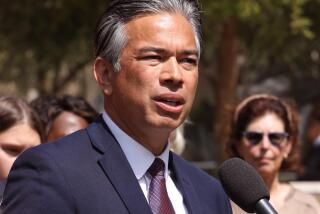Redistricting panel cancels second draft of legislative maps
- Share via
The citizens panel that for the first time is determining California’s new voting districts has canceled second drafts of its proposed maps, drawing heavy criticism Monday from interest groups that complained of being left out of the process.
Under pressure to meet a July 28 deadline for finishing the new boundaries, the California Citizens Redistricting Commission decided not to release a second draft of them this week as scheduled but to continue working on what it hopes will be the final maps. Commissioners said that would allow them to concentrate on gathering more information and crafting the best possible districts.
Some critics said the commission’s decision, made Saturday on a 13-1 vote, shortchanged the public. Initial maps were released in June and the commission has been revising them.
“The process is not transparent at all right now,” said Tony Quinn, who was an advisor to Republicans in past redistricting efforts. “The public can’t provide input if it doesn’t see the maps.”
An activist group called California Friends of the African American Caucus decried the commission’s vote as its “latest shenanigans” and an “egregious decision to perform their public charge without public scrutiny.” The group already was upset by proposed boundaries that would dilute the number of black districts, particularly in the Greater Los Angeles area.
The first maps also drew opposition from the Mexican American Legal Defense and Educational Fund. Its members complained that the first proposals did not increase the number of Latino-majority districts even though that ethnic group represents the bulk of population growth.
The lack of second drafts will make it harder for MALDEF and other groups to educate and rally residents to provide feedback on any remaining problems, according to Steven Ochoa, national redistrict coordinator for the fund.
“We’re not happy,” Ochoa said. “They put out a first draft that was unworkable.”
The 14-member commission has been deluged with strong responses from interest groups and individuals since the online publication of its first drafts. It will continue posting alternative versions of the maps as they are being reworked. Those versions will be available during commission meetings, starting with a session scheduled Wednesday in Sacramento.
Commissioner Jeanne Raya said Monday that the panel’s weekend decision “gives us more time to deliberate thoughtfully and it really gives us more opportunity for the public to interact with us in live drawing sessions.”
The commission must adopt a final set of boundaries by Aug. 15 after two weeks of public scrutiny.
Commissioner Mike Ward, who cast the only dissenting vote Saturday, said he felt it was important to have three drafts, saying that would have allowed “the media as well as the broad citizenry” to better understand what was being proposed.
One of the issues of contention in the process — how inmates in California prisons should be included in the new districts — drew action Monday from state lawmakers. Legislators were stripped of the redistricting task by a voter-approved ballot measure in 2008.
Assemblyman Mike Davis (D-Los Angeles) objects to the current practice of including inmates in districts where they are incarcerated, many in rural areas, rather than in the communities where they used to live.
Because voting lines are drawn in part based on ethnic populations, undercounting minority residents can reduce their representation in areas where they are concentrated.
“Some communities are disenfranchised,” Davis said of the current process. “Prison-based gerrymandering unfairly dilutes the voting strength of communities of color, given the rate of African Americans and Latinos in California prisons, collectively more than 60%.”
Davis has introduced legislation that would require the prison system to provide data on inmates’ home communities for the next redistricting effort. The state Senate Appropriations Committee approved the measure Monday. It now goes to the Senate floor for action.
More to Read
Sign up for Essential California
The most important California stories and recommendations in your inbox every morning.
You may occasionally receive promotional content from the Los Angeles Times.












